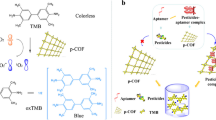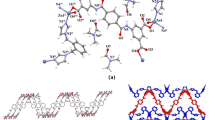Abstract
A novel triphenyl ether amine (TPEA) has been synthesized to develop a customized receptor for cyanide ions. TPEA is selective for CN− ions in the existence of a number of competitive anions like HSO4−, H2PO4−, ClO4−, OAc−, and halides. The proposed receptor responds linearly to CN− ions up to a concentration of 400 µM with a detection limit of 0.4 µM and with a binding constant of 4.16 × 107 M−1. The response of the receptor for CN− ions was validated by voltammetric methods. TPEA has also been studied as a probe for the detection of water in acetonitrile.
Graphic abstract
Amine derivative of triphenyl ether (TPEA) exhibited both voltammetric and colorimetric responses for the selective detection of cyanide ions in an aprotic solvent.











Similar content being viewed by others
References
Mondal S, Ali SS, Manna S, Maiti K, Uddin MR, Mandal S, Mandal D, Mahapatra AK (2017) A benzopyrylium–phenothiazine conjugate of a flavylium derivative as a fluorescent chemosensor for cyanide in aqueous media and its bioimaging. New J Chem 41(21):12581–12588
Beneto AJ, Siva A (2017) Highly selective colorimetric detection of cyanide anions in aqueous media by triphenylamine and phenanthro (9, 10-d) imidazole based probes. Photochem Photobiol Sci 16(2):255–261
Rezaeian K, Khanmohammadi H, Dogaheh SG (2018) Studies on a multifunctional chromo-fluorogenic sensor for dual channel recognition of Zn 2 + and CN– ions in aqueous media: mimicking multiple molecular logic gates and memory devices. New J Chem 42(3):2158–2166
Paul S, Ghosh P, Bhuyan S, Mukhopadhyay SK, Banerjee P (2018) Nanomolar-level selective dual channel sensing of Cu 2+ and CN– from an aqueous medium by an opto-electronic chemoreceptor. Dalton Trans 47(4):1082–1091
Xu Z, Chen X, Kim HN, Yoon J (2010) Sensors for the optical detection of cyanide ion. Chem Soc Rev 39(1):127–137
Organization WH (2004) Guidelines for drinking-water quality, vol 1. World Health Organization, Geneva
Casella IG, Gatta M (2001) Electrocatalysis and detection of carbohydrates byanion-exchange chromatography at a gold substrate electrode modified with nickel cyanide ions. Electroanalysis 13(7):549–554
Bohrer D, Do Nascimento P, Pomblum SG, Seibert E, de Carvalho LM (1998) Polarographic determination of cyanide as nickelcyano complex in blood plasma after selective extraction in a methylene blue impregnated polyethylene column. Fresenius’ J Anal Chem 361(8):780–783
Dadfarnia S, Shabani AMH, Tamadon F, Rezaei M (2007) Indirect determination of free cyanide in water and industrial waste water by flow injection-atomic absorption spectrometry. Microchim Acta 158(1–2):159–163
Shan D, Mousty C, Cosnier S (2004) Subnanomolar cyanide detection at polyphenol oxidase/clay biosensors. Anal Chem 76(1):178–183
Recalde-Ruiz D, Andres-Garcia E, Diaz-Garcia M (2000) Fluorimetric flow injection and flow-through sensing systems for cyanide control in waste water. Analyst 125(11):2100–2105
Niu Q, Lan L, Li T, Guo Z, Jiang T, Zhao Z, Feng Z, Xi J (2018) A highly selective turn-on fluorescent and naked-eye colorimetric sensor for cyanide detection in food samples and its application in imaging of living cells. Sens Actuators B 276:13–22
Hu R, Feng J, Hu D, Wang S, Li S, Li Y, Yang G (2010) A rapid aqueous fluoride ion sensor with dual output modes. Angew Chem Int Ed 49(29):4915–4918
Chawla HM, Shukla R, Goel P (2014) Sensitive recognition of cyanide through supramolecularly complexed new calix [4] arenes. New J Chem 38(11):5264–5267
Maity D, Vyas G, Bhatt M, Paul P (2015) Detection of NaCN in aqueous media using a calixarene-based fluoroionophore containing ruthenium (II)-bipyridine as the fluorogenic unit. RSC Adv 5(8):6151–6159
Long C, Hu J-H, Ni P-W, Yin Z-y, Fu Q-Q (2018) A novel colorimetric and ratiometric fluorescent CN− sensor based on rhodamine B hydrazone derivatives in aqueous media and its application in sprouting potatoes. New J Chem 42(20):17056–17061
Chao J, Li Z, Zhang Y, Huo F, Yin C, Tong H, Liu Y (2016) A ratiometric fluorescence probe for monitoring cyanide ion in live cells. Sens Actuators B 228:192–199
Zhang Q, Zhang J, Zuo H, Wang C, Shen Y (2016) A novel colorimetric and fluorescent sensor for cyanide anions detection based on triphenylamine and benzothiadiazole. Tetrahedron 72(9):1244–1248
Chemchem M, Yahaya I, Aydıner B, Seferoğlu N, Doluca O, Merabet N, Seferoğlu Z (2018) A novel and synthetically facile coumarin-thiophene-derived Schiff base for selective fluorescent detection of cyanide anions in aqueous solution: synthesis, anion interactions, theoretical study and DNA-binding properties. Tetrahedron 74(48):6897–6906
Sheykhi-Estalkhjani A, Mahmoodi NO, Yahyazadeh A, Nadamani MP (2018) Synthesis of new bis-benzylidene-hydrazides as a sensitive chromogenic sensor for naked-eye detection of CN¯ and AcO¯ ions. Tetrahedron 74(37):4868–4874
Stephens P, Devlin F, Chabalowski C, Frisch MJ (1994) Ab initio calculation of vibrational absorption and circular dichroism spectra using density functional force fields. J Phys Chem 98(45):11623–11627
Miehlich B, Savin A, Stoll H, Preuss H (1989) Results obtained with the correlation energy density functionals of Becke and Lee, Yang and Parr. Chem Phys Lett 157(3):200–206
Lee C, Yang W, Parr RG (1988) Development of the Colle-Salvetti correlation-energy formula into a functional of the electron density. Phys Rev B 37(2):785
Becke AD (1993) Density-functional thermochemistry. III. The role of exact exchange. J Chem Phys 98(7):5648–5652
Fisch M, Trucks G, Schlegel H, Scuseris G, Robb M, Cheeseman J, Montgomery J, Vreven T, Kudin K, Burant J (2003) Gaussian 03 (revision B. 05). Gaussian Inc, Pittsburgh, PA
Sharma R, Chhibber M, Mittal SK (2016) A new ionophore for chemical sensing of F−, CN− and Co 2+ using voltammetric, colorimetric and spectrofluorimetric techniques. RSC Adv 6(56):51153–51160
Ding Y, Li T, Zhu W, Xie Y (2012) Highly selective colorimetric sensing of cyanide based on formation of dipyrrin adducts. Org Biomol Chem 10(21):4201–4207
Hudnall TW, Gabbaï FP (2007) Ammonium boranes for the selective complexation of cyanide or fluoride ions in water. J Am Chem Soc 129(39):11978–11986
Sun Y, Wang G, Guo W (2009) Colorimetric detection of cyanide with N-nitrophenyl benzamide derivatives. Tetrahedron 65(17):3480–3485
Saha S, Ghosh A, Mahato P, Mishra S, Mishra SK, Suresh E, Das S, Das A (2010) Specific recognition and sensing of CN– in sodium cyanide solution. Org Lett 12(15):3406–3409
Keshav K, Torawane P, Kumawat MK, Tayade K, Sahoo SK, Srivastava R, Kuwar A (2017) Highly selective optical and reversible dual-path chemosensor for cyanide detection and its application in live cells imaging. Biosens Bioelectron 92:95–100
Renny JS, Tomasevich LL, Tallmadge EH, Collum DB (2013) Method of continuous variations: applications of job plots to the study of molecular associations in organometallic chemistry. Angew Chem Int Ed 52(46):11998–12013
Benesi HA, Hildebrand J (1949) A spectrophotometric investigation of the interaction of iodine with aromatic hydrocarbons. J Am Chem Soc 71(8):2703–2707
Committee AM (1987) Recommendations for the definition, estimation and use of the detection limit. Analyst 112(2):199–204
Goswami S, Das AK, Manna A, Maity AK, Fun H-K, Quah CK, Saha P (2014) A colorimetric and ratiometric fluorescent turn-on fluoride chemodosimeter and application in live cell imaging: high selectivity via specific SiO cleavage in semi aqueous media and prompt recovery of ESIPT along with the X-ray structures. Tetrahedron Lett 55(16):2633–2638
Mittal K, Kumar S, Kaur N (2019) Enhanced performance of CNT-doped imine based receptors as Fe(III) sensor using potentiometry and voltammetry. Electroanalysis 31(7):1229–1237
Wei TB, Yan GT, Li H, Zhu YR, Shi BB, Lin Q, Yao H, Zhang YM (2016) A highly sensitive and selective “turn-on” fluorescence sensor for rapid detection of cyanide ions in aqueous solution. Supramol Chem 28(7–8):720–726
Kumari N, Jha S, Bhattacharya S (2011) Colorimetric probes based on anthraimidazolediones for selective sensing of fluoride and cyanide ion via intramolecular charge transfer. J Org Chem 76(20):8215–8222
Acknowledgements
Authors are thankful to the Director, Thapar Institute of Engineering and Technology, Patiala for providing research facilities and financial support. We are also thankful to Sophisticated Analytical Instruments Laboratories (SAI Labs) for providing NMR facilities.
Author information
Authors and Affiliations
Corresponding author
Additional information
Publisher's Note
Springer Nature remains neutral with regard to jurisdictional claims in published maps and institutional affiliations.
Electronic supplementary material
Below is the link to the electronic supplementary material.
Rights and permissions
About this article
Cite this article
Gupta, S., Chhibber, M. & Mittal, S.K. Amine derivative of triphenyl ether as an optical sensor for the detection of cyanide ions and traces of water in acetonitrile supported with voltammetric studies. J Appl Electrochem 50, 185–195 (2020). https://doi.org/10.1007/s10800-019-01382-3
Received:
Accepted:
Published:
Issue Date:
DOI: https://doi.org/10.1007/s10800-019-01382-3




